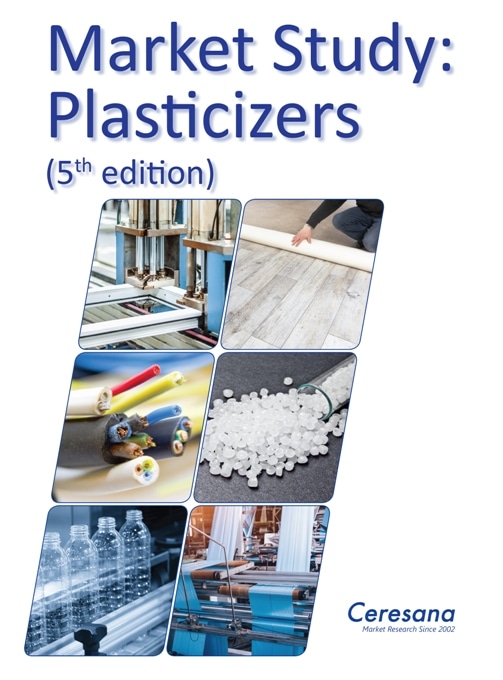Plasticizers are one of the best-selling chemicals. They are needed to make brittle plastics, rubbers, paints and coatings as well as adhesives more smooth, flexible, and soft. “PVC floors, cables, plastic toys or packaging – many everyday products contain plasticizers,” Oliver Kutsch, CEO of Ceresana, explains. “Even deodorants and perfumes require these additives.” The latest, already fifth plasticizer report by the market research company Ceresana forecasts the demand for this controversial but so far indispensable material to increase to about 10.5 billion tonnes worldwide until 2026.

Alternatives to Phthalates Are in Demand
Since phthalates are considered as harmful to health and environment and were already banned from many applications, processors of plasticizers are increasingly looking for phthalate-free alternatives. However, DEHP (bis(2-ethylhexyl)phthalate) was still the most frequently used plasticizer type in 2018 with 3.24 million tonnes. About one third of the plasticizer market was accounted for by the phthalates DINP (diisononyl phthalate) and DIDP (diisodecyl phthalate). However, phthalates are likely to continue to lose market shares in the years to come. In contrast, analysts at Ceresana expect demand for phthalate-free plasticizers to increase by 3.3% to about 2.3 million tonnes.
Plastics Are the Largest Application Area
In 2018, about 7.45 million tonnes of plasticizers were utilized for plastic products, especially for PVC. 2.33 million tonnes were used for films alone, followed closely by cables and profiles. Until 2026, Ceresana expects the segment profiles to account for the highest increase in plasticizer demand at rates of 3.0% per year. This development can be explained by, among others, the globally rising energy efficiency awareness: Energy-saving plastic windows are increasingly replacing aluminum or wooden window profiles.
Major Consumer is Asia
Plasticizer processing in Asia-Pacific accounted for about 60% of global demand in 2018. Due to above-average growth rates, demand in this world region will presumably rise to about 6.5 million tonnes in the next years. Asia is followed by Western Europe with currently 12% and North America with 11% of plasticizer demand.
The Study in Brief:
Chapter 1 provides a description and analysis of the global plasticizer market, including forecasts up to 2026: demand and revenues are explained for each region of the world. Furthermore, global and regional demand per product type and application area is analyzed.
The following plasticizer types are examined in detail:
- Bis(2-ethylhexyl)phthalate (DEHP)
- Diisononyl Phthalate (DINP) and Diisodecyl Phthalate (DIDP)
- Other Phthalates
- Non-Phthalates
Application areas analyzed in this study are:
- Profiles
- Films
- Cables
- Floorings
- Other Plastics
- Elastomers
- Paints and Coatings
- Adhesives
Chapter 2 provides demand and revenue data for 45 countries in total. Furthermore, the individual countries are analyzed in detail in regard to demand per application area.
Chapter 3 provides company profiles of the largest manufacturers of plasticizers – clearly arranged according to contact details, revenues, profit, product range, production sites, and profile summary. In-depth profiles of 65 producers are given, including Arkema S.A., BASF SE, Dow Inc., Eastman Chemical Company, Evonik Industries AG, Kao Corporation, Lanxess AG, LG Chem, Ltd., Mitsubishi Chemical Holdings Corporation, and Nan Ya Plastics Corp.